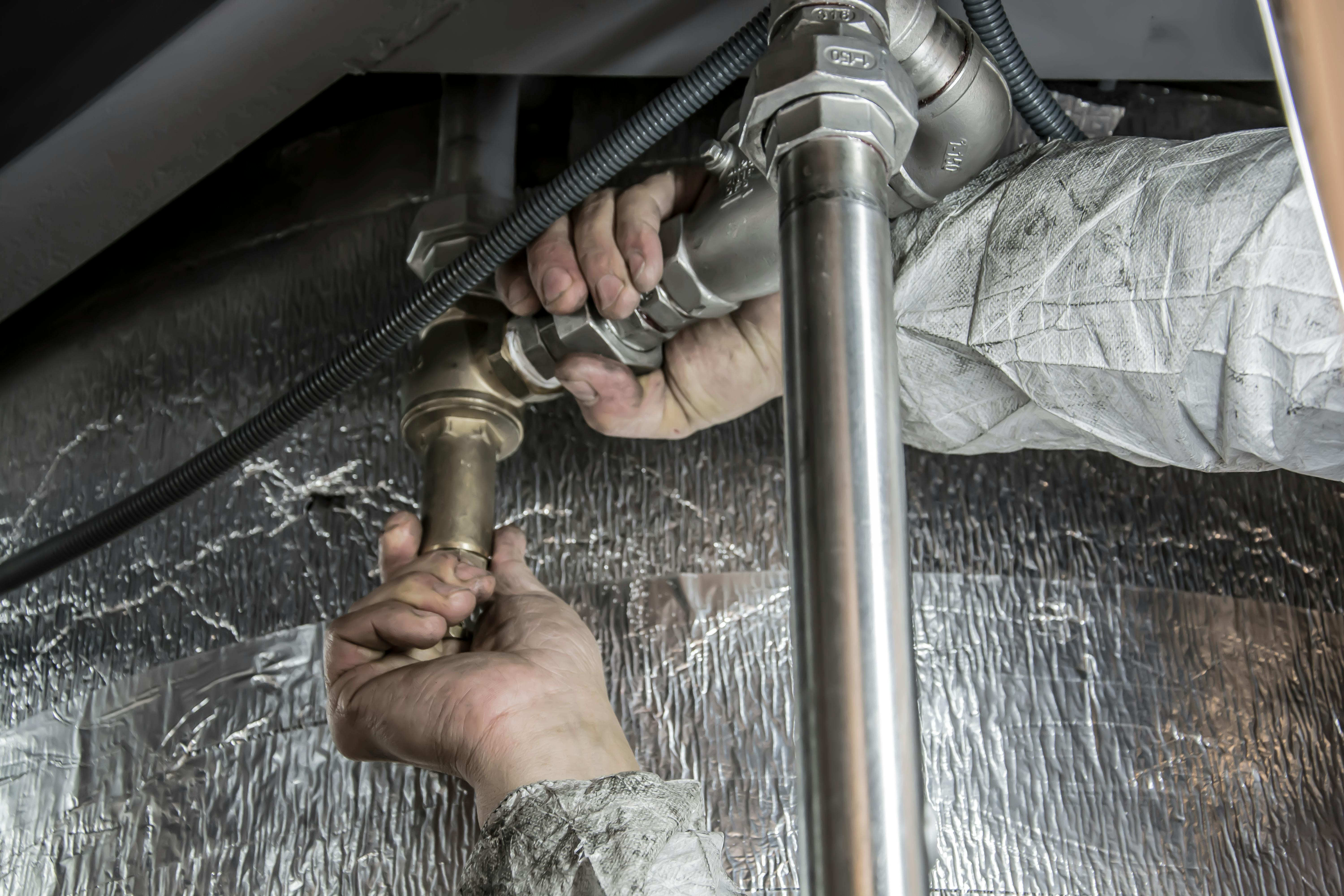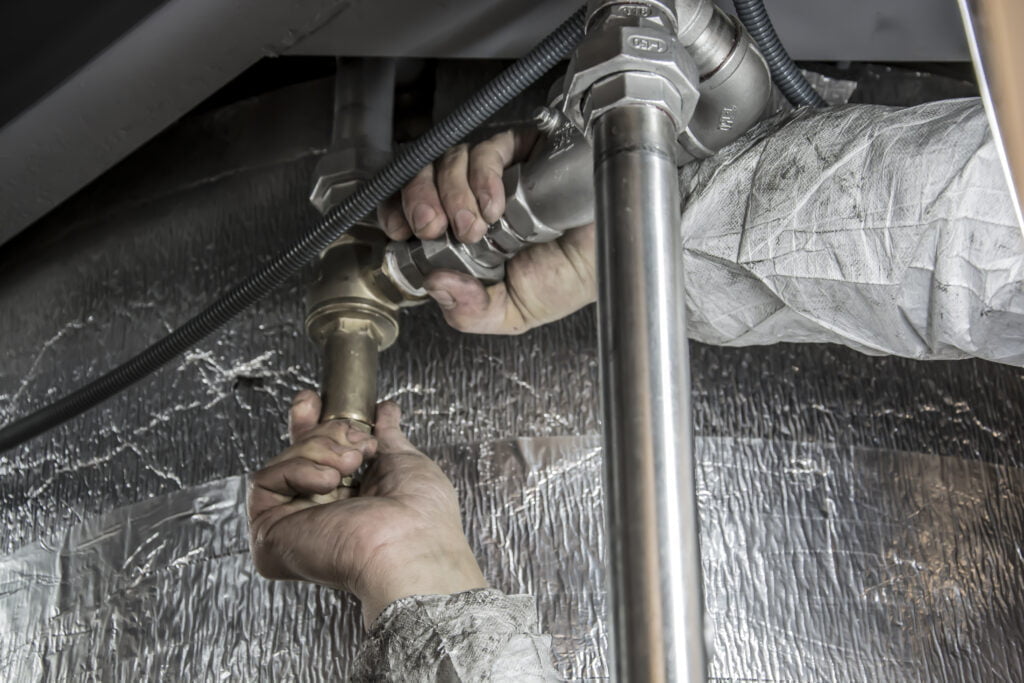So you’re faced with a pesky leaking faucet and it’s driving you crazy. You’ve got that constant drip-drip sound echoing in your bathroom, keeping you up at night, and wasting valuable water. But fear not, because fixing a leaky faucet is actually simpler than you might think. In this article, we’ll guide you through the step-by-step process of how to solve this common household issue, so you can stop the drip and regain your peace and sanity. Fixing a leaky faucet may seem like a daunting task, but with the right tools and a little know-how, you can easily tackle this common household issue. In this comprehensive guide, we will walk you through the step-by-step process of repairing a leaky faucet. From identifying the type of faucet to preventing future leaks, we’ve got you covered. So let’s dive in and get that faucet back in working order!

Identify the Type of Faucet
Before embarking on your repair journey, it’s crucial to determine the type of faucet you’re dealing with. There are four main types of faucets: compression, cartridge, ball, and ceramic disk faucets. Each type has its unique mechanism and requires different repair techniques.
Compression Faucet
Compression faucets are the most traditional type and are commonly found in older homes. They have separate handles for hot and cold water and are recognizable by their two-valve design. If your faucet has a compression mechanism, you will need to replace the rubber washers located inside the valve seat to fix any leaks.
Cartridge Faucet
Cartridge faucets are more modern and have a single handle that controls both the temperature and flow of water. To identify a cartridge faucet, look for a cylindrical body and a small plastic or metal cartridge underneath the handle. Leaks in cartridge faucets usually occur due to worn-out O-rings or damaged cartridges.
Ball Faucet
Ball faucets are also single-handled, but they have a distinctive round ball-shaped cap above the spout. To fix a leaky ball faucet, you’ll need to replace the ball assembly, which includes multiple parts such as springs and seals.
Ceramic Disk Faucet
Ceramic disk faucets are known for their durability and smooth operation. They have a ceramic cylinder that controls the water flow and temperature. If you have a leaky ceramic disk faucet, you may need to replace the ceramic disk cartridge.
Now that you’ve identified the type of faucet, it’s time to gather the necessary tools for the repair.
Gather the Necessary Tools
Having the right tools can make your repair job much easier. Here’s a list of essential tools you’ll need:
Adjustable Wrench
An adjustable wrench will come in handy for loosening and tightening various parts of the faucet. Make sure to get one that fits the size of your faucet components.
Screwdriver
A screwdriver is a versatile tool that you’ll need for disassembling and reassembling certain faucet parts. A Phillips-head screwdriver is commonly used for most faucets, but check your faucet’s screws to be sure.
Allen Wrench
Some faucets, especially cartridge and ceramic disk types, may require an Allen wrench to remove specific parts. Check the size of your faucet’s Allen screws to determine the right wrench size.
Plumber’s Tape
Plumber’s tape, also known as Teflon tape, is used to create a watertight seal on threaded connections. It helps prevent leaks around pipe threads, ensuring a secure fit.
Plumber’s Putty
Plumber’s putty is a soft, moldable substance used to create a watertight seal around certain faucet parts or fixtures. It’s commonly used when installing new faucets or repairing leaks in specific areas.
Replacement Parts
Depending on the type of faucet and the cause of the leak, you may need to have some replacement parts on hand. These can include compression faucet washers, O-rings, cartridges, ball assemblies, or ceramic disk cartridges. It’s a good idea to identify the specific parts you need before starting the repair process.
Now that you have the necessary tools, let’s move on to the first step: turning off the water supply.
Turn off the Water Supply
Before you begin dismantling the faucet, it’s crucial to turn off the water supply to prevent any water damage or accidents. There are two main ways to do this:
Under the Sink Valve
Most faucets have individual shut-off valves located under the sink. Look for small valves connected to the water supply lines leading to your faucet. Turn these valves clockwise to shut off the water flow.
Main Water Valve
If you can’t find individual shut-off valves or want to cut off the water supply to your entire house, locate the main water valve. This valve is typically found near your water meter or where the main water line enters your home. Turn the valve clockwise to shut off the water flow.
Once the water supply is turned off, you can safely proceed to the next step: dismantling the faucet.
Dismantle the Faucet
Dismantling the faucet involves removing the various components to access and replace any faulty parts. The process will vary depending on the type of faucet you have. Here’s a breakdown of the dismantling process for each faucet type:
Compression Faucet
For compression faucets, start by removing the decorative cap on the handle, if present. Use a screwdriver to unscrew the handle and remove it. Next, you’ll see a packing nut, which you should unscrew with an adjustable wrench. Once the packing nut is removed, you can access the valve stem. Take note of the order in which the components are installed, as you’ll need to reassemble them in the same order. Use an adjustable wrench or pliers to unscrew the valve stem and remove it. Finally, you’ll find the rubber washer attached to the bottom of the valve seat. Replace the old washer with a new one and reassemble the faucet in reverse order.
Cartridge Faucet
To dismantle a cartridge faucet, start by removing the decorative cap on the handle, if applicable. Use a screwdriver to unscrew the handle and remove it. You’ll notice a retaining clip securing the cartridge in place. Use pliers or an adjustable wrench to remove the retaining clip, then pull out the cartridge. Inspect the cartridge for any visible signs of damage or wear, such as torn O-rings. If necessary, replace the cartridge with a new one and reassemble the faucet.
Ball Faucet
For ball faucets, begin by carefully removing the cap or handle to expose the ball assembly. You may need to use an Allen wrench or a screwdriver, depending on the faucet model. Once the ball assembly is visible, use pliers to unscrew the cap covering the assembly. Take note of the position of the springs and seals inside the ball assembly before removing them. Inspect the ball for any signs of damage or wear, and replace it if necessary. Reassemble the faucet, making sure to place the springs and seals correctly.
Ceramic Disk Faucet
Dismantling a ceramic disk faucet involves removing the handle and spout to access the ceramic disk cartridge. Begin by unscrewing the handle, often requiring an Allen wrench. Once the handle is removed, unscrew the dome-shaped cap under the handle, which will expose the ceramic disk cartridge. Carefully lift the ceramic disk cartridge out of the faucet body and inspect it for any signs of damage or wear. If needed, replace the cartridge with a new one and reassemble the faucet.
Now that you’ve successfully disassembled the faucet, let’s move on to the next step: replacing the faulty parts.
Replace the Faulty Parts
Replacing faulty parts is essential to fix your leaky faucet. Depending on the type of faucet and the source of the leak, you may need to replace different components. Here are the main parts you might need to replace for each faucet type:
Compression Faucet Washer
For compression faucets, the most common cause of leaks is a worn-out rubber washer located at the bottom of the valve seat. To replace the washer, remove the old one and clean any debris around the valve seat area. Place a new washer of the same size in the valve seat and reassemble the faucet.
O-Rings
Cartridge and ceramic disk faucets often experience leaks due to worn-out O-rings. To replace the O-rings, remove the old ones and clean the groove where they sit. Apply plumber’s grease to the new O-rings to ensure a proper seal. Slide the new O-rings into their respective grooves and reassemble the faucet.
Cartridge
If your cartridge faucet continues to leak even after replacing the O-rings, the cartridge itself may be the culprit. Carefully remove the old cartridge and insert a new one of the same model. Follow the manufacturer’s instructions to ensure the cartridge is properly seated and secured. Reassemble the faucet, making sure all components fit snugly.
Ball Assembly
Ball faucets may require the replacement of the entire ball assembly if the leaks persist. Remove the old ball assembly, taking note of the position of the springs and seals inside. Install a new ball assembly of the same model, making sure to place the springs and seals correctly. Reassemble the faucet, ensuring all parts are tightened properly.
Ceramic Disk Cartridge
For ceramic disk faucets, if replacing the O-rings didn’t solve the leaks, you may need to replace the ceramic disk cartridge. Remove the old cartridge and install a new one of the same model. Be careful not to overtighten the cartridge to avoid damaging it. Reassemble the faucet with the new ceramic disk cartridge in place.
Now that you have replaced the faulty parts, it’s time to clean and reassemble the faucet.
Clean and Reassemble the Faucet
Before reassembling the faucet, it’s a good idea to clean all the components thoroughly. Remove any debris, mineral deposits, or buildup from the various parts using an old toothbrush or a soft cloth. You can also use a solution of vinegar and water to dissolve stubborn mineral deposits.
Once the components are clean, carefully reassemble the faucet in the reverse order of the dismantling process. Pay close attention to the proper placement of each part and ensure everything fits snugly but not overly tight. Tighten any screws or nuts as needed, but be careful not to overtighten, as this may cause damage.
With the faucet reassembled, you’re now ready to move on to the next step: checking for leaks.

Check for Leaks
Now that the faucet is back together, it’s time to turn on the water supply and check if any leaks persist. Here’s what you need to do:
Turn on the Water Supply
Slowly turn on the water supply either through the under-sink valves or the main water valve, depending on how you shut it off. Gradually increase the water flow and observe the faucet for any signs of leaking.
Inspect for Drips or Leaks
Carefully examine the faucet and its connections for any drips or leaks. Pay attention to the base of the faucet, the handles, and any joints or connections. If you notice any leaks, try to identify their source and address them accordingly. This may involve tightening various parts, resealing connections with plumber’s tape or putty, or replacing additional faulty components.
If you find that your faucet is leak-free, congratulations! You’ve successfully repaired the leak. But before you wrap up, there are a few additional adjustments you can make to optimize your faucet’s performance.
Make Additional Adjustments
After fixing the initial leak, there are a few extra steps you can take to ensure your faucet functions smoothly and efficiently. Consider the following adjustments:
Check the Water Pressure
Turn on the faucet and observe the water pressure. If it’s too high or too low, you may need to adjust the water pressure regulator or install a new one altogether. Proper water pressure is crucial for optimal performance and prolonging the lifespan of your faucet.
Adjust the Faucet Handle
If the handle feels loose or wobbly, you can make adjustments to tighten it. Depending on your faucet model, there may be a set screw beneath the handle that you can tighten using an appropriate screwdriver or Allen wrench. This will help stabilize the handle and ensure smooth operation.
Lubricate Moving Parts
To keep your faucet running smoothly, you can lubricate the moving parts with a silicone-based lubricant. Apply a small amount of lubricant to the cartridge, ball assembly, or ceramic disk cartridge, depending on your faucet type. This will reduce friction and make turning the handle easier.
By making these additional adjustments, you can ensure that your faucet operates at its best. However, it’s important to remember that prevention is always better than cure.
Prevent Future Leaks
To avoid dealing with leaky faucets in the future, regular maintenance and proper usage are key. Here are a few preventative measures you can take:
Regular Maintenance
Perform routine maintenance on your faucets to keep them in optimal condition. This includes periodically cleaning the aerator, removing mineral deposits, and inspecting for any signs of wear or damage. Addressing minor issues early on can prevent more significant leaks from occurring down the line.
Proper Usage
Proper usage of your faucet can also help prevent leaks. Avoid over-tightening the handles when turning off the water, as excessive force can cause damage to the internal components. Additionally, be mindful of not slamming the handles or spout shut, as this can weaken the seals and lead to leaks. Treat your faucet gently, and it will reward you with years of leak-free service.
While most leaky faucet issues can be resolved with some DIY skills, there are situations where it’s best to call in a professional.
When to Call a Professional
While fixing a leaky faucet is often a manageable task, there are instances where it’s advisable to seek professional help. Consider the following scenarios:
Persistent Leaks
If you’ve attempted to repair your faucet but the leaks persist, it may be an indication of a more serious underlying problem. Irreversible damage to the faucet’s internals or issues with the plumbing system could require professional intervention. A licensed plumber can assess the situation and offer the best course of action.
Lack of Confidence or Experience
If you don’t have much experience with DIY projects or lack the confidence to tackle a faucet repair, it’s perfectly okay to seek professional assistance. Not only will this ensure the job is done correctly, but it will also save you time, effort, and potentially costly mistakes.
Remember, it’s always better to err on the side of caution when dealing with plumbing issues. Professional plumbers have the expertise and equipment to handle complex repairs and can provide long-term solutions.
In conclusion, learning how to fix a leaky faucet is a valuable DIY skill that can save you money and frustration. By identifying the type of faucet, gathering the necessary tools, and following the step-by-step process, you can successfully repair most leaks. Remember to turn off the water supply, dismantle the faucet, replace faulty parts, clean and reassemble, and check for leaks. Make additional adjustments as needed and take preventative measures to avoid future leaks. And if in doubt, don’t hesitate to call a professional. With these tips and tricks, you’ll be able to keep your faucets in excellent condition and bid farewell to those annoying drips and leaks.



